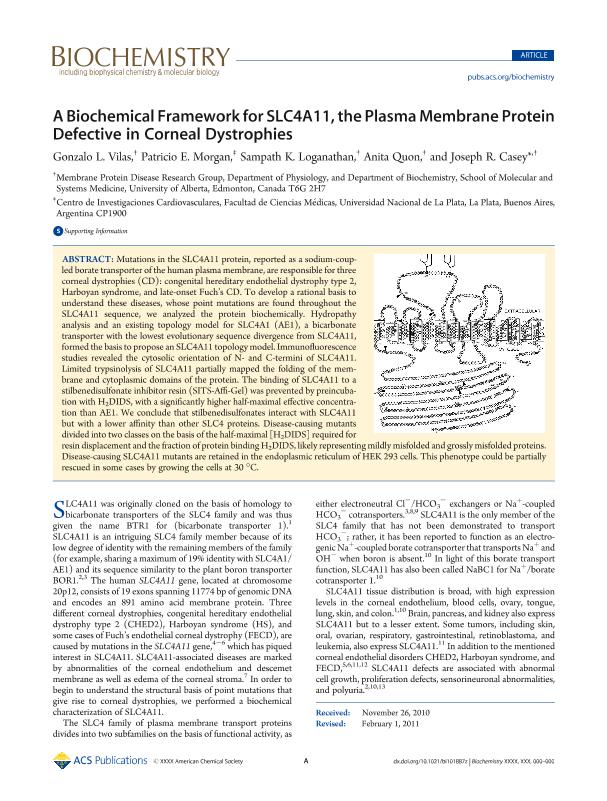Artículo
A biochemical framework for SLC4A11, the plasma membrane protein defective in corneal dystrophies
Fecha de publicación:
03/2011
Editorial:
American Chemical Society
Revista:
Biochemistry
ISSN:
0006-2960
Idioma:
Inglés
Tipo de recurso:
Artículo publicado
Clasificación temática:
Resumen
Mutations in the SLC4A11 protein, reported as a sodium-coupled borate transporter of the human plasma membrane, are responsible for three corneal dystrophies (CD): congenital hereditary endothelial dystrophy type 2, Harboyan syndrome, and late-onset Fuch’s CD. To develop a rational basis to understand these diseases, whose point mutations are found throughout the<br />SLC4A11 sequence, we analyzed the protein biochemically. Hydropathy analysis and an existing topology model for SLC4A1 (AE1), a bicarbonate transporter with the lowest evolutionary sequence divergence from SLC4A11, formed the basis to propose an SLC4A11 topology model. Immunofluorescence studies revealed the cytosolic orientation of N- and C-termini of SLC4A11.<br />Limited trypsinolysis of SLC4A11 partially mapped the folding of the membrane and cytoplasmic domains of the protein. The binding of SLC4A11 to a stilbenedisulfonate inhibitor resin (SITS-Affi-Gel) was prevented by preincubation with H2DIDS, with a significantly higher half-maximal effective concentration than AE1. We conclude that stilbenedisulfonates interact with SLC4A11 but with a lower affinity than other SLC4 proteins. Disease-causing mutants divided into two classes on the basis of the half-maximal [H2DIDS] required for resin displacement and the fraction of protein bindingH2DIDS, likely representing mildly misfolded and grossly misfolded proteins. Disease-causing SLC4A11 mutants are retained in the endoplasmic reticulum of HEK 293 cells. This phenotype could be partially rescued in some cases by growing the cells at 30 C.
Palabras clave:
Slc4a11
,
Eye
,
Distrophy
,
Structure
Archivos asociados
Licencia
Identificadores
Colecciones
Articulos(CIC)
Articulos de CENTRO DE INVEST.CARDIOVASCULARES (I)
Articulos de CENTRO DE INVEST.CARDIOVASCULARES (I)
Citación
Vilas, Gonzalo L.; Morgan, Patricio Eduardo; Loganathan, Sampath K.; Quon, Anita; Casey, Joseph R.; A biochemical framework for SLC4A11, the plasma membrane protein defective in corneal dystrophies; American Chemical Society; Biochemistry; 50; 12; 3-2011; 2157-2169
Compartir
Altmétricas




